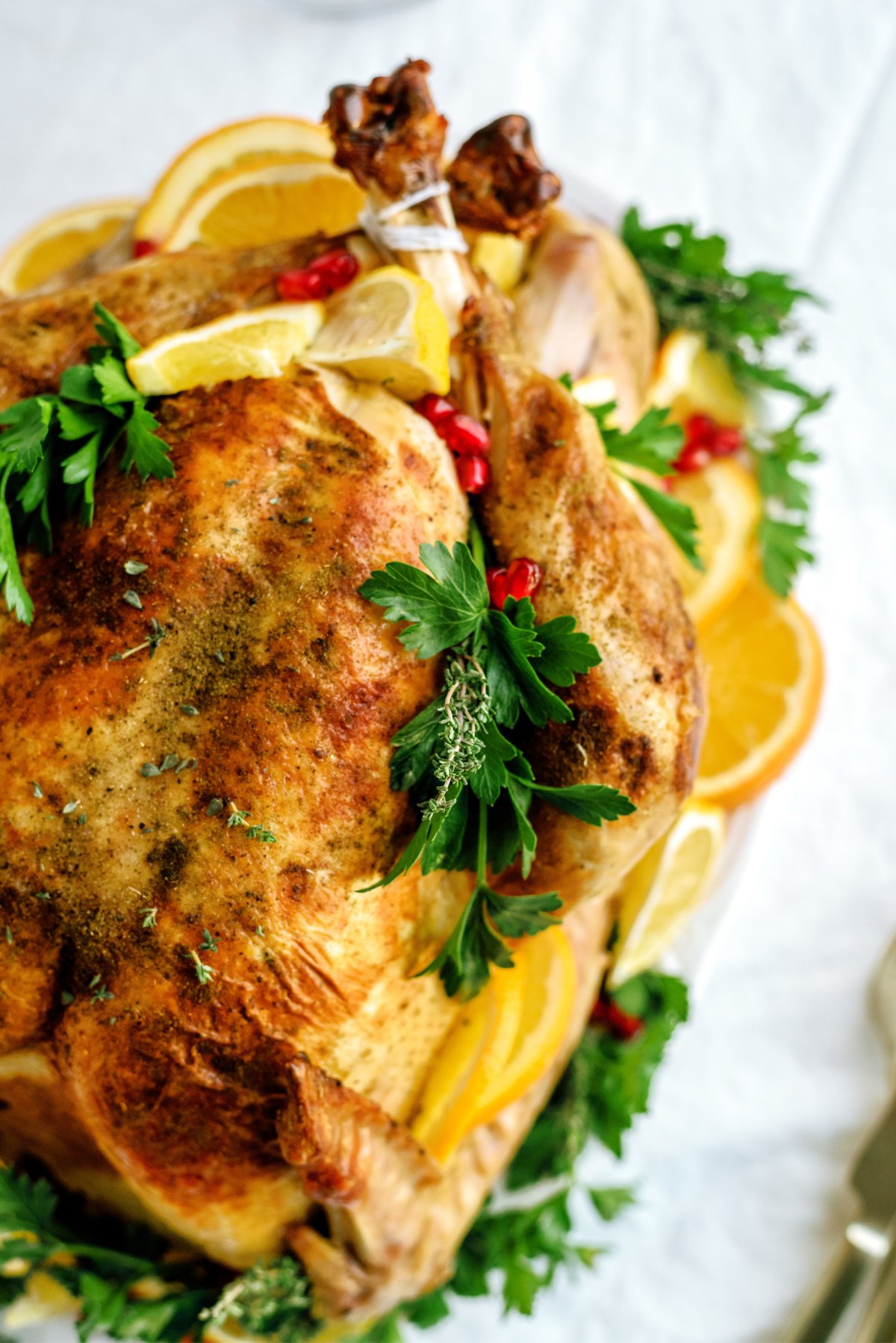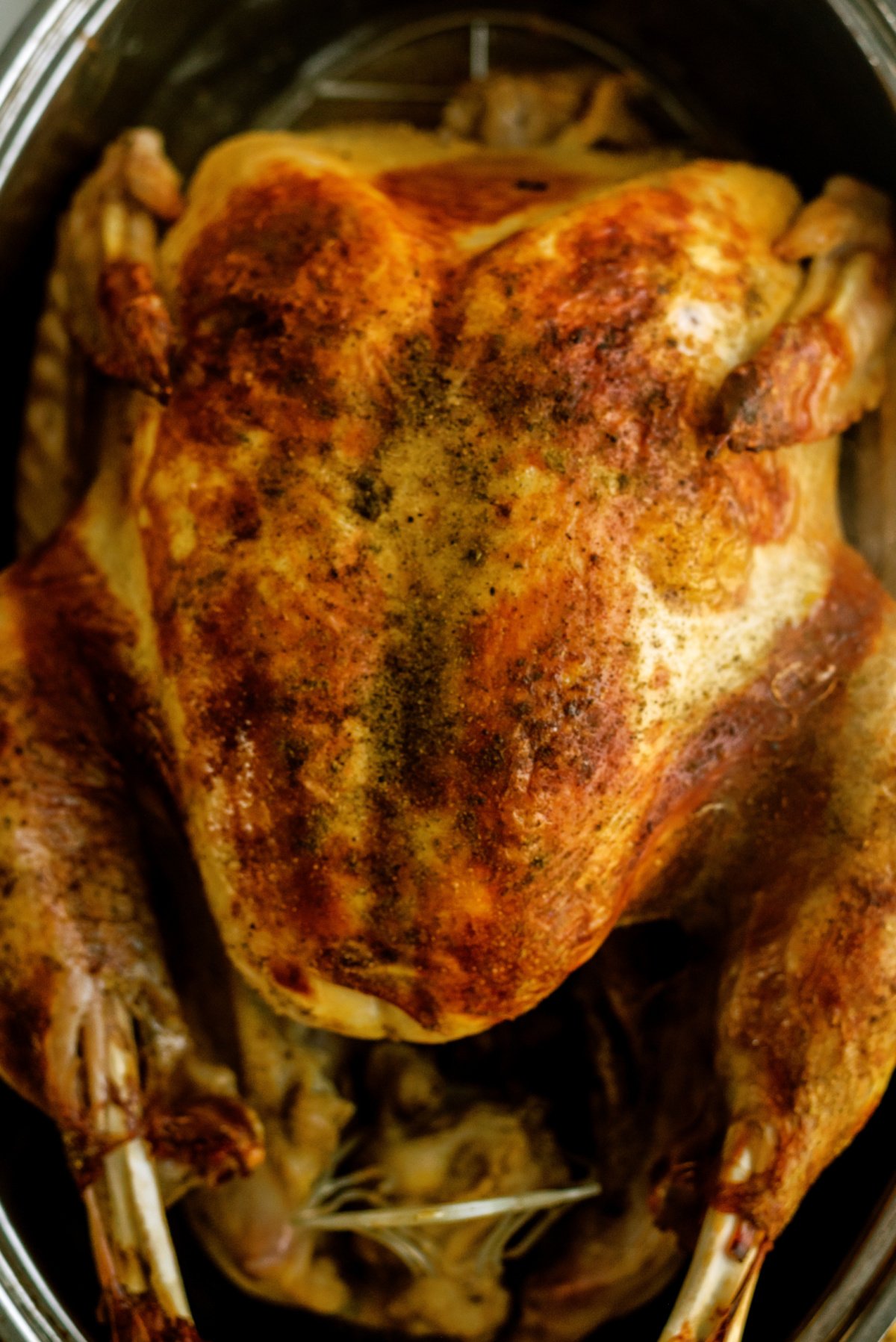This post may contain affiliate sales links. Please read my disclosure policy.
One of the secrets to a super moist, totally out of this world flavorful turkey is to brine your bird! Using a wet brine for your turkey takes some planning ahead, but that doesn’t mean it’s difficult (spoiler alert…it’s not!). Use my step by step instructions along with my best tips and tricks below. I also have a Dry Brine method that doesn’t use any liquid and makes for a wonderfully delicious turkey as well.

What is Brining?
Brining means making a salt water solution and submerging the turkey in it for 12-48 hours before roasting. This method helps retain the moisture in the turkey and keeps it from drying out. This is called wet brining. The best part of using a wet brine is that you can add in all kinds of aromatics like lemon, garlic, herbs and anything else your little heart desires! There is also a Dry Brine method that basically is rubbing salt on the outside of the turkey and letting it sit for 12-48 hours before roasting. I have a helpful little tutorial if you’re interested on reading up about that.

Use Kosher Salt
When it comes to brines of any kind, the main ingredient is SALT. Most brine recipes use kosher salt and kosher salt only. Iodized table salt is much more sharp and salty. We don’t want our turkey to be salty, just ‘seasoned’ and kosher salt is the best way to do that. I used Morton Coarse Kosher Salt and it worked perfectly.
Fresh vs Frozen Turkey
A brine is a good opportunity to add extra moisture and flavor to your Thanksgiving Turkey. How you do this is obviously your choice. A fresh turkey comes basically ready to roast…no prep work needed. Adding a brine would add delicious flavor. But what about a frozen turkey?
If you have read the fine print…meaning read the entire package that a frozen turkey comes in, you will probably recognize the following sentence: “contains up to 8% of a solution of water, salt, spices and natural flavor for tenderness and juiciness”. This basically means that your frozen turkey already comes with a brine of sorts. If you defrost your bird in the fridge for a few days, it will be sitting in this solution…therefore semi-brining itself before you roast it. Should you still use a brine on a frozen turkey? I would say yes. Not only does it leave you with an overall juicier bird, but it also adds the flavors you want your turkey to have.
Standard Brining Ratio
The standard brining ratio is 4 quarts (1 gallon) of water to 1 cup of salt. You’ll want the liquid brine to completely cover your turkey, so if your bird is on the larger side, simply mix up more water/salt in the proper ratio and add to the bag/pot.

How to Brine a Turkey
This is more of a method than a recipe, but I added the following aromatics to my salt water mixture.
- Lemons
- Oranges
- Garlic
- Rosemary
- Sage
- Peppercorns
- Bay Leaves



Bring Brine Ingredients to a Boil, then Reduce to Simmer
Add all ingredients to a large pot and cook over medium-high heat. Bring to a boil, stirring occasionally. Reduce heat and simmer for 30 minutes. Salt should be fully dissolved.



Pour Completely Cooled Brine over Turkey
Remove from heat and allow to cool completely. Place turkey in a brining bag and/or pot with lid large enough to submerge whole turkey in brine. This is the Brining Bag I used.
Pour brine over turkey and cover with lid or plastic wrap.
Refrigerate
Refrigerate for 24-48 hours.

When You’re Ready to Roast the Turkey
When you’re ready to roast the turkey, remove from brine, rinse and pat dry. Do NOT season with more salt…it is fully seasoned and ready to roast. (Feel free to add other seasonings as desired.)
Allow turkey to sit out for about an hour before placing in hot oven. Roast as you normally would. If you want to smoke your turkey, I have step by step instructions for that in my Easy Smoked Turkey recipe post.

Won’t My Turkey Be Too Salty?
No! Just like when you season a large roast and add a lot of salt, this is exactly the same. It’s a 12-25 pound turkey…it needs a lot of salt. Instead of just rubbing it on the exterior and sticking it in the oven, we allow the turkey to ‘soak up’ the salt and flavors so it gets flavored the entire way through. It won’t be too salty.
You of course, DO NOT want to re-season your turkey with salt before roasting. It has all the salt it needs, but feel free to add any other seasonings you want besides salt (like poultry seasoning).

Will My Turkey Drippings Be Too Salty?
No. Just like I mentioned above, your drippings are coming from a properly seasoned turkey. It shouldn’t taste too salty at all. If you’re worried about it, you can add some chicken or turkey stock to the bottom of your roasting pan when you are noticing those drippings are starting to appear. OR another great option is to simply place your turkey on a bed of onions, celery, carrots and fresh herbs for a more flavorful gravy. Yum!

Other Flavor Options
There are lots of varieties and combinations of flavors that are delicious when it comes to poultry. There are lots of rubs and seasonings out there. While I don’t recommend changing the salt or sugar, the herbs and spices are definitely up for interpretation. Here are a few tasty options that you could add to your dry brine this Thanksgiving:
- Sage: a classic Thanksgiving/turkey flavor!
- Rosemary: more earthy and strong flavor
- Thyme: mild and classic
- Herbs de Provence: a mixture of french herbs and spices in this blend
- Lemon or Orange Zest: to add floral and bright flavors
- Poultry Seasoning: a classic blend of dried herbs that compliment chicken or turkey well
- Cloves: for a distinct warm holiday flavor
Classic Thanksgiving Sides
So, you make this delicious Brined Turkey…what do you serve with it? Here are some classic side dishes and desserts that are popular and traditional for Thanksgiving, but you can be sure to view my full list of Thanksgiving Side Dishes.
- Dinner Rolls – a must have
- Amazing Thanksgiving Stuffing or Cornbread Stuffing
- Perfect Scalloped Potatoes or Funeral Potatoes – both are extremely popular on my site around the holidays
- Thanksgiving Turkey Gravy
- Mashed Potatoes or Slow Cooker Mashed Potatoes
- Green Bean Casserole (with bacon!!)
- No-Knead Crescent Rolls – includes make ahead directions
- Cranberry Sauce
- Pumpkin Pie or Sweet Potato Pie
- Buttery Apple Pie
- Pumpkin Pecan Cobbler – one of my most popular Thanksgiving Dessert Recipes ever!
Let me know if the comments how your bird turned out this year! Brining is my go to method and I won’t be turning back anytime soon. Happy Thanksgiving, friends!

How to Brine a Turkey
Ingredients
- 1 gallon water 4 quarts
- 1 cup kosher salt coarse
- 1 head garlic sliced in half lengthwise to reveal cloves
- 4 lemons or oranges, cut into large wedges
- 1 cup fresh herbs sage, thyme, oregano, rosemary are all good choices
- 1 tbsp whole peppercorns
- 2 Bay Leaves
Equipment
- Brining Bag optional
Instructions
- Add all ingredients to a large pot and cook over medium-high heat. Bring to a boil, stirring occasionally. Reduce heat and simmer for 30 minutes. Salt should be fully dissolved.
- Remove from heat and allow to cool completely.
- Place turkey in a brining bag and/or pot with lid large enough to submerge whole turkey in brine.
- Pour brine over turkey and cover with lid or plastic wrap.
- Refrigerate for 24-48 hours.
- When you're ready to roast the turkey, remove from brine, rinse and pat dry. Do NOT season with more salt…it is fully seasoned and ready to roast. (Feel free to add other seasonings as desired.) Allow turkey to sit out for about an hour before placing in hot oven.
Video
Notes
Nutrition






I have read that you should not brine your bird for more than 24 hrs, yet these instructions say up to 48 hrs. Why the difference, what is the risk of brining taht long? Any?